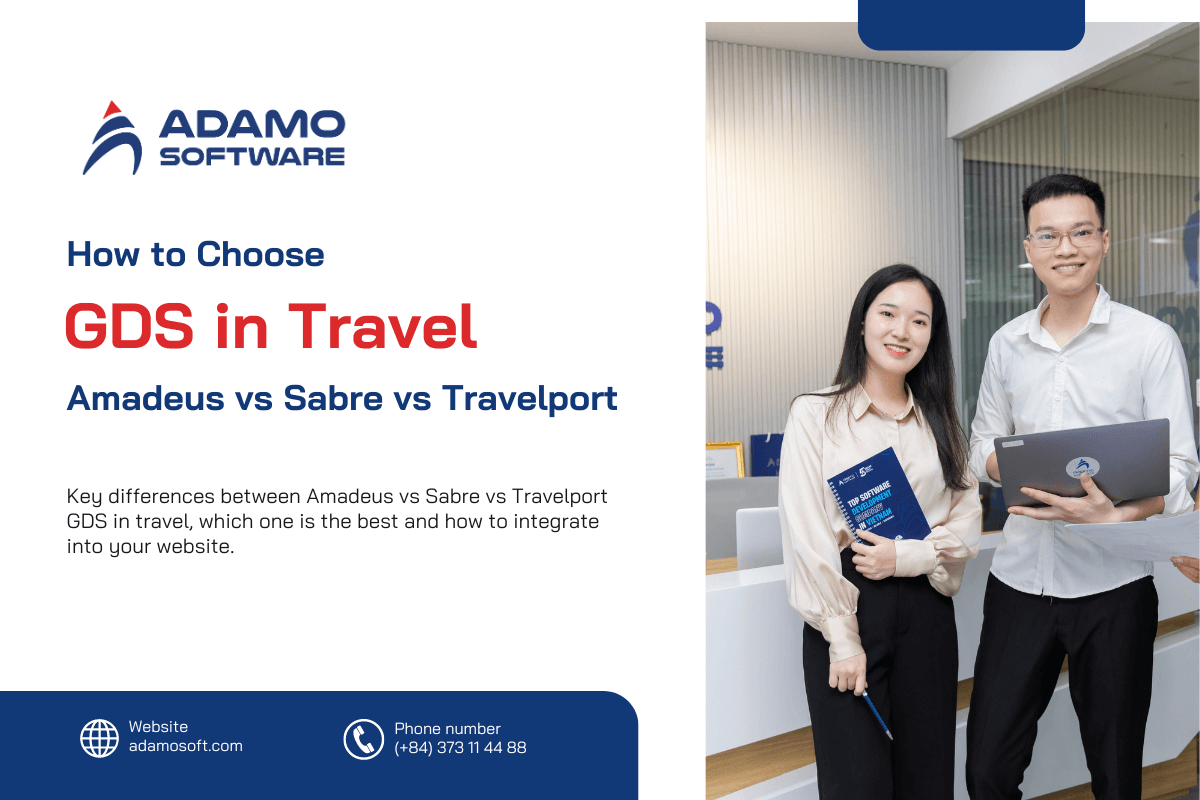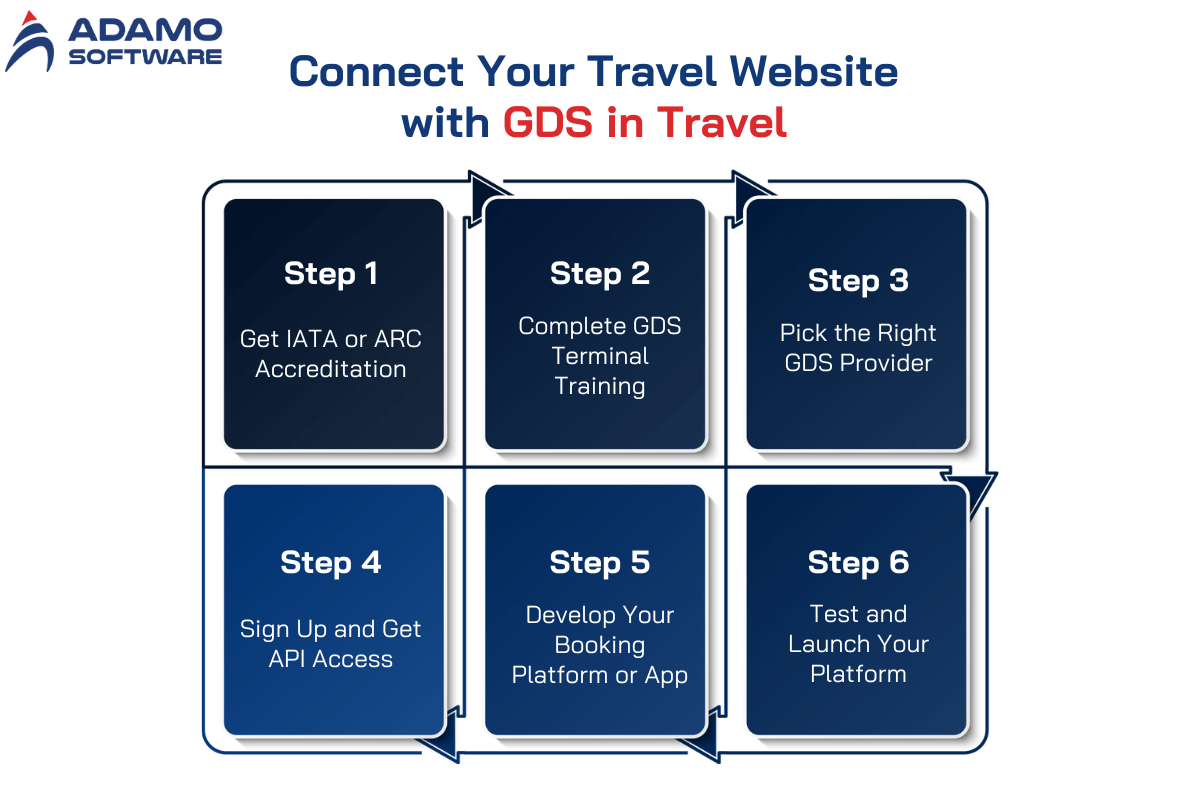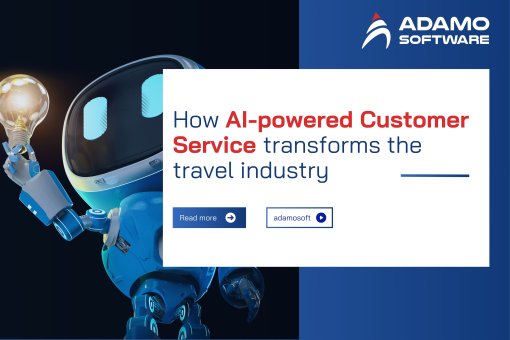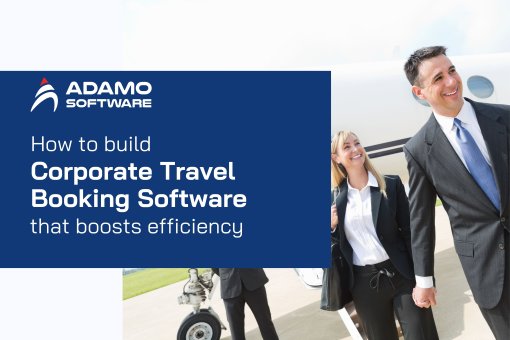How to Choose GDS in Travel among Amadeus vs Sabre vs Travelport

Nowadays, travel agencies, travel management companies, and other travel service providers are using technology platforms to access and share travel-related content and services. This is known as the global distribution system (GDS in travel) market.
As the GDS market was valued at $7.5 billion in 2022 and is expected to grow to $15.4 billion by 2032, GDS platforms are crucial for making the booking process easier, providing users with a wide range of travel options, and ensuring accurate and up-to-date information as the travel industry becomes more diverse and competitive.
Amadeus, Sabre, and Travelport are the top GDS providers in the market. Many travel companies struggle to choose the best one among these three.
Our blog today will help you. We’ll go over the main features of each GDS in travel, explain the key differences between them, and provide a complete guide on how to integrate GDS into your website.
I. What is GDS in Travel?
A GDS is a computer-based network that connects various reservation systems into one central platform. It’s widely used in the travel industry, especially by airlines, hotels, and car rental companies. GDS in travel allows different online travel agencies to sell tickets for the same flights, hotel rooms, or car rentals.
1. How Do GDSs in Travel Work?
Global Distribution System acts as a bridge between vendors (hotels and airlines) and service providers (travel agencies). To understand about this bridge, check this GDS System: How to connect all from airlines and hotels. Most large GDSs like Amadeus, Sabre and Travelport are linked with major travel agencies, while smaller, cheaper GDSs may connect to fewer.
Here’s how it works:
_ Vendors (hotels, airlines, etc.) sign up and connect their inventory (available rooms, seats, cars) to a GDS in travel
_ Once connected, users can book services through various portals linked to the GDS
_ And to prevent overbooking, the inventory is updated in real-time, so that the availability information is always current
_ Vendors can also update their services and prices across all portals connected to the GDS in travel
2. Main Features of a Global Distribution System to Consider
_ Pooled inventory
A GDS with pooled inventory allows you to offer all your hotel rooms or flight seats across all distribution channels at once. Without this feature, you’d have to manage your inventory separately for each channel, limiting your booking potential and revenue.
_ Commission-free structure
Your GDS should help you increase your bookings without cutting into your earnings with commission fees. Look for a GDS provider that doesn’t charge a commission just for processing bookings to your system.
_ Integration capabilities
GDS in travel can fully integrate with your existing Property Management System (PMS), online booking engine, and channel manager. Thanks to this, you can manage your distribution strategy effectively.
_ Comprehensive reporting
What’s more, GDS in travel should provide detailed reporting tools to help you make informed decisions about your marketing and distribution strategies. Consider choosing a provider that offers tools to analyze your booking data thoroughly.
_ Ability to target specific markets
A GDS allows you to reach and tap into important market segments. You should be able to filter your access based on geographic locations and specific types of travelers.
II. Why Travel Companies Need a GDS in TraveL
GDS plays a crucial role in the travel industry as it consolidates booking, pricing, and service options across various sectors into a unified platform.
Also, GDS in travel systems provide real-time data from international airlines, global hotel inventories, car rental services, and other travel-related services, enabling Online Travel Agents (OTAs) to offer a wide range of choices and process bookings quickly and efficiently.
OTA heavily relies on GDS systems to provide diverse booking options for flights, hotels, and car rentals. Integrating GDS into travel portals is now more and more popular among OTAs as it simplifies the booking of various travel services and automates transactions between service providers and agencies.
Travel agency software can also utilize GDS in travel to offer a comprehensive range of travel-related services to consumers due to managing global data, rates, and inventories, ensuring real-time availability service booking, thus making the booking process more efficient for both operators and vendors.
GDS in travel is effective for promoting travel savings and has become fundamental in the supply of travel products to retailers in the online marketplace.
There are two major GDS systems dominating the market, which are Amadeus, Sabre API Integration, and Travelport. These systems operate independently and are widely used by airlines and travel agencies on both B2B and B2C platforms. Understanding the key differences between Amadeus, Sabre, and Travelport helps you choose the most suitable system for your needs.
III. What is the Differences Between Travelport, Amadeus, and Sabre GDS?
1. Travelport
Travelport is one of the top GDS in travel available today. It provides travel agents with access to a wide range of travel-related content, such as flights, hotels, car rentals, sightseeing tours, transfers, and other services, through web services APIs.
What’s more, Travelport helps travel agents expand their business worldwide and increase their ROI. With Travelport, agents can find the best airline tickets, hotel rooms, car rentals, and more for their clients, customizing and offering data based on specific criteria and itineraries.
2. Amadeus
Amadeus is a well-known and leading global distribution system that operates in over 190 countries. It assists travel agencies in serving travelers better and growing their global business by helping customers find the best deals. Amadeus also allows travel businesses to manage their operations better by reducing costs and boosting revenue.
3. Sabre
Sabre is another leading GDS provider that is transforming the travel industry through its market reach. It is used by thousands of travel suppliers and users for market planning, distribution, and business operations. Today, many travel agencies around the world rely on the Sabre GDS in travel as their main booking platform. Sabre allows travel agents, end-users, and businesses to book flight tickets, rental cars, hotel rooms, tour packages, and other travel products through a computer reservation network.
IV. Amadeus vs Sabre vs Travelport: Which is the Best GDS in Travel?

1. Inventory and Coverage
Amadeus GDS System
Amadeus is one of the most popular GDS in travel systems available today, known for its extensive reach and comprehensive services.
_ Hotels: Amadeus connects with more than 421,000 unique hotel properties, including independent and small-chain hotels.
_ Flights: With Amadeus, you can access real-time, up-to-date flight information such as flight status and pricing.
_ Car rentals: Amadeus also allows travel agents to add car rental options to their existing travel booking portals. So that customers have a wide range of car rental choices, and more simply and quicker booking the car they need.
_ Cruises: Amadeus offers various types of cruises booking services, such as availability for various cruises, transfers, special services, excursions, and more.
_ Other content:
– Amadeus provides access to 90 railway services across 190 countries
– Over 300,000 tours and activities are available for booking
– Includes more than 30 bookable and over 100 searchable cruise companies and ferry lines
– There are services from 21 insurance providers available for booking
Sabre GDS system
Sabre GDS in travel is the world’s largest electronic travel reservation system, providing travel management companies and agents with a variety of solutions to efficiently serve their customers.
_ Flights: Sabre connects travel agencies to more than 400 airlines, both full-service and low-cost carriers. Of these, 170 airlines offer additional services and branded fares. Sabre also operates its own passenger service system, SabreSonic, similar to Amadeus.
_ Hotels: Sabre gives agents access to over 1.6 million lodging options. Starting in 2024, Sabre will also serve as the central reservation system provider for Hyatt hotels, beginning the migration of their inventory.
_ Other content: What’s more, Sabre offers content from 38 car rental brands operating in 160 countries, supports 9 major national rail networks and over 50 rail operators, and includes services from 20 ocean and river cruise lines. It also offers tours from operators in countries like Canada, Germany, Austria, and Switzerland.
Travelport GDS system
Travelport is the smallest of the big three GDS in travel, but it combines the strengths of three major GDSs: Galileo, Worldspan, and Apollo. Operating in 180 countries, Travelport has a strong presence worldwide, particularly in Eastern Europe and Africa, and is expanding in Asia and the Americas.
_ Flights: Travelport connects travel agencies to 460 airlines, providing access to 340 branded fares and ancillary services from 150 carriers.
_ Hotels: By partnering with Booking.com, Travelport has added pre- and post-pay rates across 140,000 properties, boosting its total accommodation options to over a million.
_ Other content: Travelport includes offerings from 46 car rental brands, including pre-paid rates from Hertz, and supports 25 rail operators. It also provides packages from major cruise lines and tour operators. In 2022, Travelport integrated with Trainline, Europe’s leading rail booking platform, allowing GDS in travel clients to book and manage cross-European train travel.
2. NDC Support
New Distribution Capability (NDC) is an XML standard developed by the International Air Transport Association (IATA) to enhance how airline services are distributed. Thanks to NDC, airlines can offer richer content and ancillary services directly to consumers, thereby increasing flexibility and customer choice in booking flights.
GDS Amadeus
Amadeus is actively developing its NDC-X program and has achieved level 3 status as an NDC aggregator. So that Amadeus API users can support end-to-end ancillary booking flows with selected airlines.
GDS Sabre
Sabre was recognized by IATA as a level 3 NDC IT provider in early 2018. And Sabre’s compatibility with IATA’s NDC standards and its capability to offer a full range of NDC services.
GDS Travelport
Although Travelport is the smallest, it was the first among GDSs to attain level 3 compliance as an NDC aggregator, a necessary status for providing NDC services. Initially focused on airlines, Travelport’s NDC product roadmap evolved in 2019 to integrate with OTAs.
3. GDS API Integration
An API, or application programming interface, facilitates the exchange of data and functionalities between different software systems. It acts as a control panel for developers, allowing them to connect software components without needing to delve into source code.
Amadeus API
Amadeus API connects users to a vast repository of travel data used by leading travel websites worldwide. It also provides solutions that unlock comprehensive travel content and services, along with resources for developers to leverage these APIs effectively.
Benefits of Amadeus API Integration
_ Access to a wide range of features covering flights, hotels, car transfers, pricing, and booking services
_ Displays extensive options for airlines, car rentals, and hotels
_ Provides a centralized booking management system
_ Enables seamless integration with airline, car rental, and hotel travel web services
_ Provides complete control over inventory and booking management
_ Allows customization of preferred airline and hotel deals for each inventory
Sabre API
Formerly known as Sabre Web Services, Sabre APIs offer quick and flexible access to Sabre’s system functionality and product offerings. They are tailored for developers looking to create or update customized booking applications, incorporating Sabre content into various platforms.
Benefits of Sabre API Integration
_ Provides a broad array of features showcasing flights, car rentals, and hotel deals
_ Provides a single point of access to the Sabre system
_ Supports integration with any web service functionality
_ Provides fully customizable backend for bookings
_ Allows setting custom fares for each inventory
Travelport API
Travelport API is a SOAP/XML API that provides access to multiple services and transactions. It grants developers access to a variety of content including air travel, hotels, car rentals, and rail services, facilitating the development of comprehensive travel applications across desktop, web, and mobile platforms.
4. GDS Tools
Today, GDS in travel have evolved beyond mere content aggregators into full-fledged technology providers within the travel industry. Alongside their robust APIs, Amadeus, Sabre, and Travelport offer a diverse array of off-the-shelf software solutions tailored for various players in travel.
Amadeus’s Selling Platform Connect
Amadeus’s Selling Platform Connect is a standout product enabling travel agents to work seamlessly from any location with internet access. Ideal for small to medium businesses, this cloud-based platform requires no installation and receives automated updates, ensuring uniformity across the organization.
For corporate travel, Amadeus offers Cytric Travel and Expense, equipped with a mobile app for travelers, expense management tools, intuitive dashboards, and CO2 compensation reports. In 2022, they launched Outpayce, a B2B payments platform integrated into their ecosystem, facilitating supplier payments via virtual cards.
Sabre Red 360
Sabre Red 360 is a marketplace connecting sellers to suppliers, featuring comprehensive content accessible via APIs, including NDC offers. Recently, it incorporated carbon offset data, empowering users to prioritize sustainability in flight bookings.
For TMCs and corporate clients, Sabre provides GetThere, a cloud-based software for travel booking and reporting across desktop, tablet, and mobile devices. In 2022, Sabre acquired Conferma Pay to enhance its B2B payment capabilities, connecting travel businesses with over 50 banks worldwide for virtual credit card issuance.
Travelport+
Travelport+ is Travelport’s retailing platform introduced in 2021, significantly streamlining booking processes compared to traditional methods. It integrates Smartpoint Cloud to help agents create tailored travel packages and has expanded its footprint through integration with Deem, a corporate booking tool.
Contrary to acquiring a payment platform, Travelport sold its payment business eNett and parent company Opal to WEX in 2020. This strategic move marked a shift in focus towards enhancing their core travel technology offerings.
V. How to Connect Your Travel Website with GDS in Travel
If you’re thinking about starting a travel booking business, connecting to a GDS in travel is a key step. Here’s a simple guide to help you connect to GDS and get your travel booking business up and running:

1. Get IATA or ARC Accreditation
Before connecting to a GDS, it’s a good idea to get accredited by the IATA or the Airlines Reporting Corporation (ARC). While not mandatory for using a GDS, this can boost your credibility in the travel industry and lets you offer ticketing services. To apply, you’ll need to show industry experience, get a business license, and meet certain financial requirements.
2. Complete GDS Terminal Training
To use a GDS in travel effectively, you need to get training on the specific GDS system you plan to use. You can ask the GDS providers or search on other training platforms that offer courses and certifications so you can learn how to operate a GDS in travel.
3. Pick the Right GDS Provider
The next step is to choose the GDS provider that fits your business needs. As we’ve discussed the differences between Amadeus, Sabre, and Travelport, you should consider factors like the provider’s inventory size, the services they offer, their technical support, and costs. Evaluating these factors will help you pick the best GDS provider for your business.
4. Sign Up and Get API Access
To connect to a GDS in travel, sign up with your chosen provider and get API access. GDS providers will offer various API options based on what you need. You can use these APIs to integrate the GDS inventory into your booking platform or app seamlessly.
5. Develop Your Booking Platform or App
Once you have API access, you can start developing your booking platform or app. Build features to search for and book travel services using the GDS inventory. You can either develop the platform yourself if you have the technical know-how or hire a software development company that specializes in travel technology.
6. Test and Launch Your Platform
Before you go live, don’t forget to test your booking platform or app thoroughly. Make sure the integration with the GDS works smoothly and that all features function as expected.
VI. Final Thoughts
No doubt, GDS in travel is excellent for global distribution in travel networks. However, it does have downsides, like requiring extensive resources, lengthy confirmation processes, and significant resource consumption. Additionally, there’s still potential for improvement in GDS adoption for low-cost carriers and NDC content.
When it comes to choosing between Amadeus, Sabre, or Travelport, there’s no simple answer. It depends on various factors, and we hope this article has provided some clarity.
If your travel company isn’t very tech-savvy, consider hiring a travel technology consultant like Adamo Software. As a leading travel and hospitality software development company in Vietnam, Adamo offers custom travel software solutions for various businesses and entrepreneurs worldwide, including travel portal development, booking engines, property management systems, and travel agent software.











